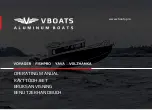
2013 Chaparral H2O Owner’s Manual
Chaparral Boats, Inc.
Nashville, GA
chaparralboats.com
2-5
Visual distress equipment must be in serviceable condition and stowed
in a readily accessible location. Equipment having a date showing useful
service life must be within the specifi ed usage date shown. Both pyro-
technic and non-pyrotechnic equipment must be U.S. Coast Guard ap-
proved.
Pyrotechnic U.S. Coast Guard approved visual distress signals and as-
sociated equipment include:
• Red fl ares, hand held or aerial
• Orange smoke, hand held or fl oating
• Launchers for aerial red meteors or parachute fl ares
Non-pyrotechnic equipment includes an orange distress fl ag and an S-O-
S electric distress light.
No single signaling device is ideal under all conditions for all purpos-
es. Consider carrying various types of equipment. Careful selection and
proper stowage of visual distress equipment are very important. If young
children are frequently aboard, you should select devices with packages
which children, but not adults, will fi nd diffi cult to open.
Sound Signaling Device
Your Chaparral boat must have a device that can produce a sound signal
when conditions require. For boats over 26 feet, the device must be able
to produce a two-second blast which can be heard a mile away. For boats
less than 26 feet, it must be able to produce a two-second blast which can
be heard one-half mile away. It can be a hand, mouth or power operated
horn or whistle. Refer to the U.S. Coast Guard’s publication “Navigational
Rules, International-Inland” for details about the appropriate signals.
RUNNING AND NAVIGATION LIGHTS
Your boat must have running and navigation lights for safe operation after
dark. Observe all navigation rules for meeting and passing. Do not run
at high speeds during night operation. Always use common sense and
good judgment.
SAFETY AFLOAT
Once your boat is launched and your excursion is underway, you need to
be aware of your surroundings and how they may affect your safety and
that of your passengers. There is no substitute for good judgment and
common sense.
Weather
Storms rarely appear without advance notice. Check the weather fore-
cast before you begin a day of boating. Be aware, however, that weather
conditions can change rapidly. If you have a marine radio, listen to the
weather reports issued by the U.S. Coast Guard and others. If you have
a portable radio, keep it tuned to a station broadcasting frequent weather
reports. Many boating clubs fl y weather signals. Learn to recognize these
signals and listen to your local forecasts before leaving port.
Your surroundings can also be a good indicator of changing weather con-
ditions. Watch for changes in wind direction or cloud formations. There is
no substitute for a good understanding of weather conditions and what to
do when the weather takes a turn for the worse.
Fog
Fog is a result of either warm-surface or cold-surface conditions. You can
judge the likelihood of fog formation by periodically measuring the air
temperature and dew point temperature. If the difference between these
two temperatures is small, fog is likely to develop. Remember the follow-
ing guidelines:
• Turn on running lights.
• Unless your boat is well equipped with charts, head for shore at the
fi rst sign of fog and wait until conditions improve. If you have charts on
board, take bearings as fog sets in, mark your position, and continue to
log your course and speed.
• Make sure all persons on board have put on their personal fl oatation
devices.
Содержание H2O 2013
Страница 16: ...DEALER COPY WHITE CUSTOMER COPY YELLOW...
Страница 84: ...2013 Chaparral H2O Owner s Manual Chaparral Boats Inc Nashville GA chaparralboats com 12 1 WIRING SCHEMATICS...
Страница 85: ...2013 Chaparral H2O Owner s Manual Chaparral Boats Inc Nashville GA chaparralboats com 12 2 H2O INST PNL PIGTAIL...
Страница 86: ...2013 Chaparral H2O Owner s Manual Chaparral Boats Inc Nashville GA chaparralboats com 12 3 H20 INST PNL PIGTAIL...
















































